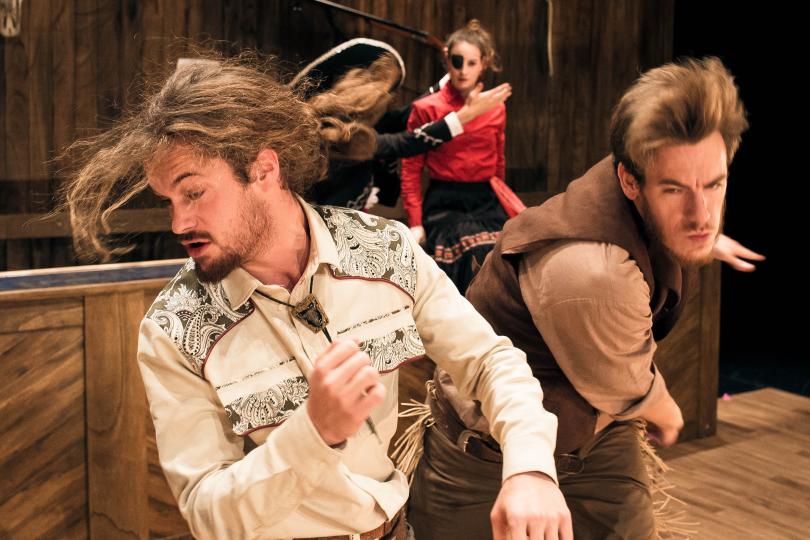Happiness gives us wingsTM

Note: Erin McNeil works at the Walker Art Center in the Visual Arts department. The opinions expressed below are hers alone and do not reflect the position of the Walker Art Center.
The Pursuit of Happiness is a thick stew of language, movement, costuming, and cultural references. A visceral kind of experience, it almost deserves to be described in terms of food or sex: it’s hot, raw, and salty. It’s “more than a minor deviation” from the Westerns, war movies, and self-built-emotionally-bankrupt Americana it distorts like a funhouse mirror. Of course, the funhouse mirror functions because it shows us both what we desperately want to be (tall, lanky thin) and what we fear the most (we are actually dumpy, short, and unlovable), while keeping the viewer in a state of suspense -- which image is real?
The performance is divided into two distinct sections: the first is a classic old-west bar, complete with a useful spittoon, perpetually messy tables, saloon doors, cowboy boots and enticingly tight blue jeans. All of the actors/dancers are part of the Slovenian EN-KNAP Group, who created the piece along with The Nature Theater of Oklahoma. The piece plays with EN-KNAP broken English, and while clearly played up for laughs, it allows for some lovely non-sequiturs and some sentence constructions that add to the unsettling ambience. “Wow. Have you considered medications?” one character asks another. As if that could actually help with the problems expressed by the first. Everything during the piece is subtitled in a gaudy frame that recalls old silent films, and helps drive home the scripted nature of the often incongruous dialogue.
This first section revels in the disconnection and violence of its characters. Actors give monologues, each more pitiable than the last, which result not in comfort but rather physical violence from the others. The over-the-top fights, complete with perfectly executed comical sound effects, have no clear reason for beginning and stop just as quickly.
The second half features the “Mexican” barkeep, played by EN-KNAP Group’s founder and Artistic Director Iztok Kovač, turned would-be script writer based (loosely, one assumes given the events that follow) on Kovač himself. The EN-KNAP Group goes to Baghdad and performs for Iraqi and American soldiers. Kovač promises the audience that the troupe didn’t “dumb down” their complex and historically rich choreography for the soldiers, instead their movement invited the soldiers to participate on their own terms. There are a few lovely moments of solidarity and explicitly homoerotic encounters that seem to show the possibility of art and dance changing our war-torn world -- only to end in the dismantling and dismembering of many of the soldiers and the troupe itself. In a memorable and incredibly macabre scene, the troupe is actually blown apart -- heads, eyes, arms -- recall Dada absurdism and the carnage that WWI had on a whole generation of artists. The parallels are not lost here, nor is the fact that modern warfare is even more extremely horrible for all that we now have robots do some of our dirty work.
Perhaps the most elegant touch is the profound impact Red Bull (lovingly called R.B. for short) has on the second half of the piece. R.B. fuels both the insurgents and NATO forces, and the resupply van is treated with religious deference by both sides. R.B. functions as a driving force and a foil, and I could help but think of the large part of the American electorate that derives sustenance from this energy drink. Professional athletes, students pulling all-nighters, frat brothers and Supermodels (sugar-free, of course), worship at the altar of this function-improving beverage. R.B promises us transcendence through the energy it “produces”-- we will make, fuck, fight, and party more. It is this detail, totally inseparable to the second half, which elevates this piece more than any other-- a ubiquitous and quintessentially American beverage, writ large across the world.
At the end of the piece, Kovač offers to sell his full story. He suggests the purchaser accompany him to a local watering hole (Liquor Lyle’s) as contracts and billfolds are too obscene for the theater. The joke here is not lost on the audience, who spent most of the performance in fits of nervous laughter. I didn’t take him up on his offer, but perhaps someone else did.




